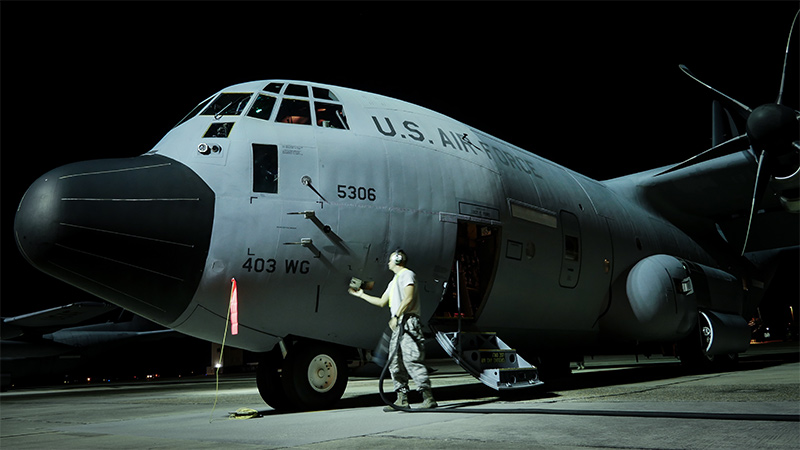Stay Up to Date
Submit your email address to receive the latest industry and Aerospace America news.
Flying a U.S. Air Force Hurricane Hunter through ferocious storms like hurricanes Harvey and Irma sounds dangerous. Statistically speaking, it’s not.
The lone crash involving the model flown these days, the Lockheed WC-130J, took place in 1974, when a Hurricane Hunter with six men aboard vanished in the South China Sea during Typhoon Bess.
Retired Lt. Col. Dave Borsi says a “tremendous amount” of training prepares the pilots, who are a mix of full- and part-time reservists based at Keesler Air Force Base in Biloxi, Mississippi. Pilots only become storm-certified by piercing the inner eye walls of hurricanes, where 185 mph (295 kph) winds, metascale vortexes, hailstones, lightning and thunderstorms prevail.
“The biggest pressure drop occurs within 10 to 15 miles of the center of the storm, depending on how wide that inner eye wall is,” says Borsi, who’s flown into hurricanes about 75 times. “There are times that the turbulence is so extreme that it isn’t possible to focus on the instrument panel. You can’t tell what’s there.”
Flying at about 10,000 feet, the crews gather and transmit data that helps weather forecasters predict where hurricanes will go next. To keep control, the pilot and co-pilot may split duties, one keeping the plane upright while the other tries to maintain a speed of about 180 knots (or about 205 mph; 330 kph). Too much faster, Borsi says, and the turbulence could shear a plane’s wings off.
Another type of mission, called a “low-level invest,” determines whether a suspected hurricane exists by looking for winds rotating in a complete counterclockwise circle. The pilots fly at 500 to 1,500 feet above water, while the crew’s weather officer gauges wind speed and direction from the waves.
The Air Force’s 10 Hurricane Hunters are the same heavy-duty workhorse as other C-130s, but they are modified with specialized weather instruments and an extended fuel tank permitting missions of up to 14 hours.
Before and after flights, maintenance crews “are working their butts off having to repair the planes as they come in,” Borsi says. “The hail and the rain can be so hard it will damage parts of the propeller — not structural parts, but it will damage parts. And they’ve got to look at [damage from] lighting strikes.”
Planes that have been exposed to severe G-forces — such as a 45-degree bank away from a vortex — get checked out, and all get a “birdbath” to remove saltwater spray and prevent corrosion. Hurricane Hunters flew 34 missions while tracking Irma, said Air Force Lt. Col. Chad Gibson.
The National Oceanic and Atmospheric Administration also has two planes that it sends into hurricanes, with scientific research being the primary goal.
The importance of the Hurricane Hunter missions can be seen in an anecdote from 2005, when a crew including Gibson was chasing Hurricane Rita to its landfall in Louisiana.
“I got a text message saying if you can get one more picture of the eye, the president would really appreciate it,” Gibson said. “We’re sending directly to NORAD and POTUS is standing there watching it.”
Editor’s note: In the U.S. Air Force photo at the top of this page, Maj. Kendall Dunn and Lt. Col. Ivan Deroche fly a WC-130J Super Hercules into Hurricane Harvey during a mission out of Keesler Air Force Base, Mississippi, on Aug. 24. Staff Sgt. Heather Heiney shot the photo.
“There are times that the turbulence is so extreme that it isn’t possible to focus on the instrument panel. You can’t tell what’s there.”
Retired Air Force Lt. Col. Dave Borsi
About Joe Stumpe
A freelance reporter based in Wichita, Kansas, Joe has written for The New York Times, Agence France-Presse and The Huffington Post.
Related Posts
Stay Up to Date
Submit your email address to receive the latest industry and Aerospace America news.





